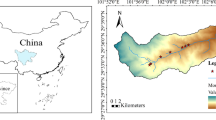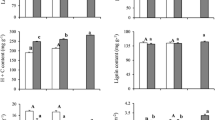Summary
The temperature and water relations of the largleafed, high-elevation species Frasera speciosa, Balsamorhiza sagittata, and Rumex densiflorus were evaluated in the Medicine Bow Mountains of southeast Wyoming (USA) to determine the influence of leaf size, orientation, and arrangement on transpiration. These species characteristically have low minimum stomatal resistances (<60 s m-1) and high maximum transpiration rates (>260 mg m-2s-1 for F. speciosa). Field measurements of leaf and microclimatic parameters were incorporated into a computer simulation using standard energy balance equations which predicted leaf temperature (T leaf) and transpiration for various leaf sizes. Whole-plant transpiration during a day was simulated using field measurements for plants with natural leaf sizes and compared to transpiration rates simulated for plants having identical, but hypothetically smaller (0.5 cm) leaves during a clear day and a typically cloudy day. Although clear-day transpiration for F. speciosa plants with natural size leaves was only 2.0% less per unit leaf area than that predicted for plants with much smaller leaves, daily transpiration of B. sagittata and R. densiflorus plants with natural leaf sizes was 16.1% and 21.1% less, respectively. The predicted influence of a larger leaf size on transpiration for the cloudy day was similar to clear-day results except that F. speciosa had much greater decreases in transpiration (12.7%). The different influences of leaf size on transpiration between the three species was primarily due to major differences in leaf absorptance to solar radiation, orientation, and arrangement which caused large differences in T leaf. Also, simulated increases in leaf size above natural sizes measured in the field resulted in only small additional decreases in predicted transpiration, indicating a leaf size that was nearly optimal for reducing transpiration. These results are discussed in terms of the possible evolution of a larger leaf size in combination with specific leaf absorptances, orientations and arrangements which could act to reduce transpiration for species growing in short-season habitats where the requirement for rapid carbon fixation might necessitate low stomatal resistances.
Similar content being viewed by others
References
Campbell GS (1977) An introduction to environmental biophysics. Heidelberg Science Library. Berlin Heidelberg New York: Springer
Drake BG, Raschke K, Salisbury FB (1970) Temperature and transpiration resistances of Xanthium leaves as affected by air temperature, humidity, and wind speed. Plant Physiol 46:324–330
Duncan WG (1971) Leaf angles, leaf area, and canopy photosynthesis. Crop Sci 11:482–485
Forseth I, Ehleringer JR (1980) Solar tracking response to drought in a desert annual. Oecologia (Berl) 44:159–163
Fritschen LJ (1965) Miniature net radiometer improvements. J Appl Met 4:528–532
Gates DM (1976) Energy exchange and transpiration. In: Lange OL, Kappen L and Schulze E-D (eds), Ecological Studies, Vol. 19, Water and Plant Life. Berlin Heidelberg New York: Springer, pp 137–147
Gates DM, Alderfer R, Taylor E (1968) Leaf temperatures of desert plants. Science 159:994–995
Gates DM, Papian LE (1971) Atlas of energy budgets of plant leaves. London-New York: Academic Press
Givnish TJ, Vermeij GJ (1976) Sizes and shapes of liane leaves. Am Nat 110:743–778
Howland HC (1962) Structural, hydraulic, and “economic” aspects of leaf venation and shape. In: Bernard EE and Kare MR (eds) Biological Prototypes and Synthetic Systems 1. New York: Plenum, pp 183–191
List RJ (1968) Smithsonian Institution Meteorological Tables. Washington: Smithsonian Institution Press
Medina E, Sobrado M, Herrera R (1978) Significance of leaf orientation for leaf temperature in an amazonian sclerophyll vegetation. Rad Env Bio 15:131–140
Mooney HA, Ehleringer JR (1978) The carbon gain benefits of solar tracking in a desert annual. Pl Cell Env 1:307–311
Nobel PS (1974) Biophysical plant physiology. San Francisco: Freeman
Parkhurst DF, Loucks OL (1972) Optimal leaf size in relation to environment. J Ecol 60:505–537
Rausher MD (1978) Search image for leaf shape in a butterfly. Science 200:1071–1073
Rechard PA, Smith VF (1972) Physical and hydrometeorological characteristics of the Snowy Range Observatory. Water Resources Series No. 30, Research Institute, Univ. Wyoming, Laramie
Schulze E-D, Eller BM, Thomas DA, Willert DJ, Brinckmann E (1980) Leaf temperatures and energy balance of Welwitschia mirabilis in its natural habitat. Oecologia (Berl) 44:258–262
Shell GSG, Lang ARG, Sale PJM (1974) Quantitative measures of leaf orientation and heliotropic response in sunflower, bean, peper, and cucumber. Agr Met 13:25–37
Shell GSG, Lang ARG (1976) Movements of sunflower leaves over a 24-H period. Agr Met 16:161–170
Smith WK (1978) Temperatures of desert plants: another perspective on the adaptability of leaf size. Science 201:614–616
Smith WK, Nobel PS (1977a) Influences of seasonal changes in leaf morphology on water-use efficiency for three desert broadleaf shrubs. Ecology 58:1033–1043
Smith WK, Nobel PS (1977b) Temperature and water relations for sun and shade leaves of a desert broadleaf, Hyptis emoryi. J Exp Bot 28:169–183
Smith WK, Geller GN (1980) Leaf and environmental parameters influencing transpiration: theory and field measurements. Oecologia (Berl) 46:308–313
Taylor SE (1975) Optimal leaf form. In: Gates DM, and Schmerl RB (eds) Ecological Studies, Vol. 12. Perspectives of Biophysical Ecology. Berlin Heidelberg New York: Springer, pp 73–86
Taylor SE, Sexton OJ (1972) Some implications of leaf tearing in Musaceae. Ecology 53:143–149
Turner NC, Incoll LD (1971) The vertical distribution of photosynthesis in crops of tobacco and sorghum. J Appl Ecol 8:581–591
Author information
Authors and Affiliations
Rights and permissions
About this article
Cite this article
Geller, G.N., Smith, W.K. Influence of leaf size, orientation, and arrangement on temperature and transpiration in three high-elevation, large-leafed herbs. Oecologia 53, 227–234 (1982). https://doi.org/10.1007/BF00545668
Received:
Issue Date:
DOI: https://doi.org/10.1007/BF00545668




